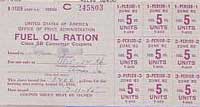Still Valuable: WWII Ration Coupons

My grandmother recently died peacefully at 95, and while my sisters and I were going through old boxes in her modest home of some 70 years, making the painful decisions about what to keep and what to give away and what to just grudgingly dispose of, I ran across something I had never seen: ration coupons from WWII, distributed by the U.S. government.
The coupons, smaller than postage stamps and stuffed into three little booklets, were for staples like sugar, gas, coffee and milk. While they no longer can be used to buy anything, I found them among the most valuable keepsakes for the monumental story they told about the very different lives of my grandmother and me.
Those of us who don't remember the war may not think much of the sacrifices made by people at home, as thousands also died abroad. My generation tends to think of war as something that happens "over there." In these tough recessionary times, perhaps some reflection on tougher times is useful.
As D-Day is recognized around the world this weekend (June 6, 1944), there will be plenty to read about the soldiers and the heroism involved as 5,300 ships and 11,000 planes crossed the English Channel and landed on the beaches of Normandy to push the German military back to Berlin and open a western front in Europe.
Back home, at my grandmother's house along the coast of California, according to stories I've been told, the windows were sometimes blacked out for fear that Japanese bombers might be on the way. My grandfather got extra ration coupons because he worked at the shipyard, I'm told.
From the Library of Congress, here is a sense of what else was going on at my grandmother's house and elsewhere around the United States as the troops stormed the beaches:
"Sixty million Americans mobilized to win the war. They held concerts and sold war bonds to raise money; rationed foodstuffs and gasoline; and salvaged scrap metal to transform it into machinery. Civilians produced everything from guns to socks for the men in the field — 25 billion rounds of 30-caliber ammunition, over 88,000 tanks, and 460,000,000 pounds of cabbage. Every twenty-four hours, factory workers rolled five new B-26 bombers off of the assembly line. At the Higgins plant in New Orleans, the first fully-integrated work force in the U.S. produced 20,094 newly-conceived landing craft, 1,500 of which put troops ashore on D-Day."
Get the world’s most fascinating discoveries delivered straight to your inbox.
Everyone saved stuff for the war effort, I've often heard from my parents and grandparents. Especially anything metal. Times were tough, and people got tougher. They got by with less. They did more to help out. Today, I think it's fair to say, we have no idea.
Old habits die hard, and to the day she died I don't think my grandmother ever threw away a rubber band, a piece of string or a paper or plastic bag. I threw a lot of that kind of stuff away the other day, along with hundreds of sheets of return address labels sent to her by the March of Dimes and other charities to which she dutifully contributed, even though she couldn't afford it and couldn't use all those labels if she lived to be 500.
And as a member of today's buy-it-and-toss-it society who has never saved rubber bands or bottle caps, much less old tires or even older cars, I felt a twinge of guilt with each little thing I tossed.
Robert Roy Britt is the Editorial Director of Imaginova. In this column, The Water Cooler, he looks at what people are talking about in the world of science and beyond.
Robert is an independent health and science journalist and writer based in Phoenix, Arizona. He is a former editor-in-chief of Live Science with over 20 years of experience as a reporter and editor. He has worked on websites such as Space.com and Tom's Guide, and is a contributor on Medium, covering how we age and how to optimize the mind and body through time. He has a journalism degree from Humboldt State University in California.



